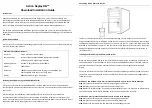
AMER-EN-IOM-ODY-0523
www.odysseybattery.com
12
Unfortunately, this recovery process is not always successful. When batteries are severely discharged,
sulfation develops and can be very difficult to remove depending on how deeply the batteries
are discharged and how long they have been in that state. This condition is not warrantable
since it is the result of abuse or neglect in the application, rather than a manufacturing defect.
Racing Vehicles Using Total Loss (No Alternator)
Standard automotive type chargers are not designed to return 105-108% of the energy removed.
They normally boost charge to 80-95% and expect the alternator to complete the charge. EnerSys
®
recommends using chargers that provide 105-108% recharge before switching to storage charge.
Chargers approved by EnerSys are listed on www.odysseybattery.com.
To fully charge an ODX-AGM31 and ODP-AGM31 battery that are routinely discharged deeply, a
minimum of 40 amps are required with charger voltage within the range of 14.1 volts to 14.7 volts.
It is imperative not to exceed 15.0V as this will cause the pressure valves to open and out-gas
hydrogen, oxygen and water from inside the battery. This will shorten the life of the battery and
cause premature failure. Some portable chargers exceed 15.0 volts, especially two-wheel garage
chargers, so charging voltages should be verified by measuring the charging voltage during the time
when the charging amperage is reducing from full output. The deep cycle charging voltage must be
within 14.1 volts minimum to 14.7 volts maximum.
If a standard automotive charger is used to boost charge a discharged battery because of an
accessory left on, it is important to make sure the charging voltage does not exceed 15.0 volts
during charge. A hand held voltmeter can be used to monitor this periodically.
12V Parallel Connection
BATTERY 1
BATTERY 2
12V MOTOR
GROUND
VEHICLE &
CONNECTION
Battery Sketch 3
24V Parallel Connection
To power a 24-volt trolling motor, you will need to connect two ODYSSEY
®
batteries in a series. As
shown in Battery Sketch 4, the negative of Battery 1 is wired to the positive of Battery 2. Hook up the
positive terminal of Battery 1 to the positive terminal of your trolling motor and the negative terminal of
Battery 2 to the negative terminal of the trolling motor.
BATTERY 1
BATTERY 2
24V MOTOR
Battery Sketch 4



































